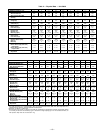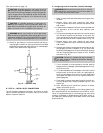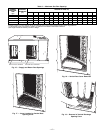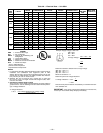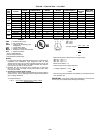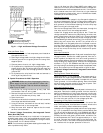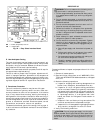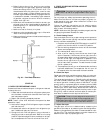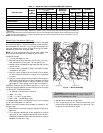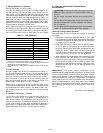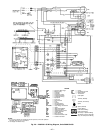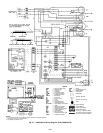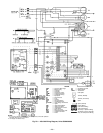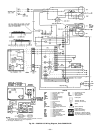
a. Before lighting the unit for the first time, perform
the following: If the gas supply pipe was not purged
before connecting the unit, it will be full of air. It is
recommended that the ground joint union be loos-
ened, and the supply line be allowed to purge until
the odor of gas is detected. Never purge gas lines into
a combustion chamber. Immediately upon detection
of gas odor, retighten the union. Allow 5 minutes to
elapse, then light unit.
b. Make sure that condenser-fan blade is correctly po-
sitioned in fan orifice. Leading edge of condenser-fan
blade should be
1
⁄
2
in. maximum from plastic fan ori-
fice (see Fig. 23).
c. Make sure that air filter(s) is in place.
d. Make sure that condensate drain trap is filled with
water to ensure proper drainage.
e. Make surethat all toolsand miscellaneous looseparts
have been removed.
START-UP
I. CHECK FOR REFRIGERANT LEAKS
Proceed as follows to locate and repair a refrigerant leak and
to charge the unit:
1. Locate leak and make sure that refrigerant system pres-
sure has been relieved and reclaimed from both high-
and low-pressure ports.
2. Repair leak following accepted practices.
NOTE: Install a filter drier whenever the system has been
opened for repair.
3. Add a small charge of R-22 refrigerant vapor to system
and leak-test unit.
4. Evacuate and reclaim refrigerant from refrigerant sys-
tem if additional leaks are not found.
5. Charge unit with R-22 refrigerant, using a volumetric-
charging cylinder or accurate scale. Refer to unit rating
plate for required charge. Be sure to add extra refriger-
ant to compensate for internal volume of filter drier.
II. START UP HEATING SECTION AND MAKE
ADJUSTMENTS
CAUTION:
Complete the required procedures given
in Pre-Start-Up section on page 22 before starting the
unit.
Do not jumper any safety devices when operating the unit.
Make sure that burner orifices are properly aligned. Un-
stable operation may occur when the burner orifices in the
manifold are misaligned.
Follow the lighting instructions on the heating section
operation label (located inside the burner or blower access
door) to start the heating section.
NOTE: Make sure that gas supply has been purged, and that
all gas piping has been checked for leaks.
A. Check Heating Control
Start and check the unit for proper heating control operation
as follows. (See furnace lighting instructions located inside
burner or blower access panel.)
1. Place the room thermostat SYSTEM switch in the HEAT
position and the fan switch in the AUTO. position.
2. Set the heating temperature control of the thermostat
above room temperature.
3. The induced-draft motor will start.
4. After a call for heating, the main burner should light
within 5 seconds. If the burners do not light, there is a
22-second delay before another 5-second try. If the burn-
ers still do not light, this sequence is repeated. If the
burners do not light within 15 minutes from the initial
call for heat, there is a lockout. To reset the control, break
the 24-v power to W.
5. The evaporator fan will turn on 45 seconds after the flame
has been established. The evaporator fan will turn off
45 seconds after the thermostat has been satisfied.
B. Check Gas Input
Check gas input and manifold pressure after unit start-up.
(See Table 5.) If adjustment is required proceed as follows.
The rated gas inputs shown in Table 5 are for altitudes from
sea level to 2000 ft above sea level. These inputs are based
on natural gas with a heating value of 1050 Btu/ft
3
at 0.65
specific gravity, or propane gas with a heating value of 2500
Btu/ft
3
at 1.5 specific gravity. For elevations above 2000 ft,
reduce input 4% for each 1000 ft above sea level. When the
gas supply being used has a different heating value or spe-
cific gravity, refer to national and local codes, or contact your
distributor to determine the required orifice size.
CAUTION:
These units are designed to consume the
rated gas inputs using the fixed orifices atspecified mani-
fold pressures as shown in Table 5. DO NOT REDRILL
THE ORIFICES UNDER ANY CIRCUMSTANCES.
C. Adjust Gas Input
The gas input to the unit is determined by measuring the
gas flow at the meter or by measuring the manifold pressure.
Measuring the gas flow at the meter is recommended for natu-
ral gas units. The manifold pressure must be measured to
determine the input of propane gas units.
Fig. 23 — Fan Blade Clearance
—23—



